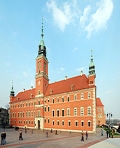Royal Castle in Warsaw
Archaeology »
Archaeological Monuments » Royal Castle in Warsaw
Royal Castle in Warsaw -
Royal Castle in Warsaw is located in Castle Square, Warsaw.
Royal Castle in Warsaw monument was established on 1791.
Primary threats to Royal Castle in Warsaw :
Historical facts of Royal Castle in Warsaw :
- The Royal Castle in Warsaw, located in the heart of Poland's capital city, is a historic landmark that holds significant cultural and political importance. With its origins dating back to the 14th century, the castle has witnessed centuries of Polish history, including royal residences, political upheavals, and remarkable architectural transformations.
- The history of the Royal Castle can be traced back to the 14th century when a small stronghold known as the "Ducal Castle" was constructed on the site. Over time, the castle grew in size and importance, eventually becoming the residence of Polish monarchs. It was during the reign of King Sigismund III Vasa in the late 16th century that the castle was expanded and transformed into a magnificent Renaissance-style palace.
- In the following centuries, the Royal Castle underwent various architectural changes and renovations. During the 18th century, under the rule of King Stanis?aw August Poniatowski, the castle was redesigned in the Neoclassical style, reflecting the prevailing architectural trends of the time. The renowned architect Domenico Merlini played a significant role in shaping the castle's appearance during this period.
- Tragically, the Royal Castle suffered severe damage during the Warsaw Uprising in 1944. The castle was deliberately destroyed by German forces as an act of retaliation against the Polish resistance. Despite the devastation, the Polish people were determined to restore their cultural heritage, and the process of rebuilding the castle commenced in the post-war years.
- The restoration of the Royal Castle was a painstaking and meticulous effort, with experts and craftsmen working tirelessly to recreate the castle's former glory. Utilizing historical records, paintings, and archaeological findings, the reconstruction aimed to replicate the castle's original appearance as closely as possible. The project became a symbol of national resilience and a testament to the Polish people's unwavering dedication to their cultural heritage.
- In 1984, the Royal Castle in Warsaw was officially reopened to the public as a museum, showcasing a vast collection of art, historical artifacts, and regal interiors. Visitors can explore the castle's lavishly decorated rooms, including the Grand Vestibule, the King's Chamber, and the Marble Room, which provide a glimpse into the opulence and grandeur of Poland's royal past.
- Today, the Royal Castle serves as a cultural and educational center, hosting exhibitions, concerts, and other events that celebrate Polish history and art. It stands as a symbol of national identity and resilience, commemorating the country's rich heritage and the indomitable spirit of the Polish people.
- In conclusion, the Royal Castle in Warsaw is a testament to Poland's rich history and architectural heritage. From its humble beginnings as a small stronghold to its magnificent Renaissance and Neoclassical transformations, the castle has endured wars and destruction, only to be meticulously restored and returned to its former glory. It stands today as a cherished cultural landmark and an emblem of national pride, inviting visitors to immerse themselves in Poland's royal legacy and historical significance.

